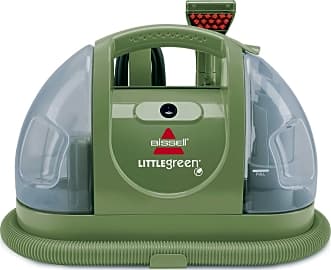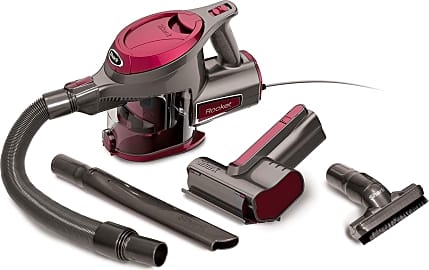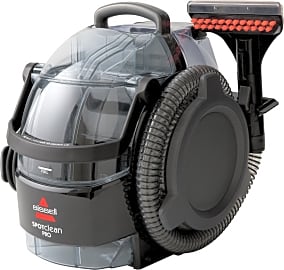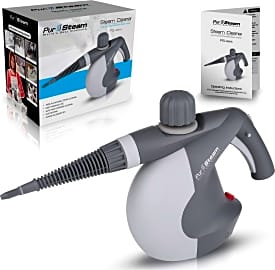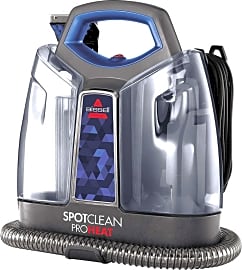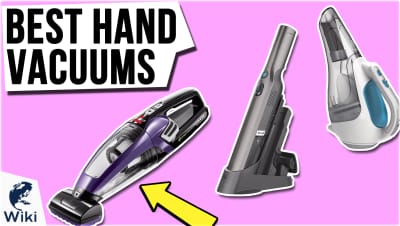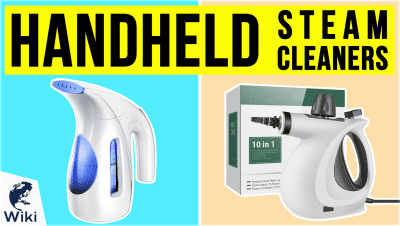The 8 Best Handheld Carpet Cleaners

This wiki has been updated 36 times since it was first published in February of 2017. There is no need to spend lots of money on professional carpet cleaning for everyday spills when these convenient handheld carpet cleaners can take care of all sorts of messes. Smaller, cost-effective alternatives to upright or industrial models, they are quick and simple to use, and fully capable of removing unsightly spots and blemishes effectively -- even set-in stains. When users buy our independently chosen editorial selections, we may earn commissions to help fund the Wiki.
Editor's Notes
September 14, 2020:
Even though there are occasional issues with their hoses, models from Bissell still come out on top when it comes to handheld and spot cleaning thanks to their ease of use and stain removal power. For most, the Bissell SpotBot Pet Deep Reach is the option to beat; its automatic cleaning cycles save your time and energy, and even stop you from dirtying your hands. The Bissell SpotClean Pro also does a fine job, as does the Bissell SpotClean ProHeat, but note that the latter doesn't have an on-board heater, despite the name. Instead, if you add hot water, the machine will keep it that way to ensure a powerful stain-fighting action.
If you need to tackle dust, debris, and hair, but don't want to drag out your full-size vacuum, the Shark Rocket Hand Vacuum is still a strong choice. Its cord could probably be a little longer for comfort, but overall, it will get the job done. The Black & Decker 16V Cordless is another hand vacuum to consider, especially if you want a model that doesn't require you to deal with a cord at all. Its less-than-stellar battery life hasn't been improved, but for the cost, it's fine for light duty.
May 29, 2019:
Cleaning the carpet is work, let's face it, but we think that these handheld carpet cleaners make the job as painless as possible. For the top spot, we still like the Bissell SpotBot Pet, largely because it does so much of the work for you. In fact, the spiral-action brush can complete 400 revolutions in a cycle, which is a great help for tough messes. There's also the Bissell Little Green ProHeat; it's not automatic like the SpotBot Pet, but it's light and still uncomplicated to use, especially since it has handy dual tanks. If you need to quickly vacuum, and don't want to fool around with water, we think the Shark Rocket Hand Vacuum is a fine option. It is indeed corded, but this means it doesn't run out of juice in the middle of cleaning. If you have your heart set on cordless, though, the Black & Decker 16V is one to consider, although the battery life isn't anything to write home about. Finally, we opted to remove the McCulloch MC1275. The flimsiness of the accessories is worrying; there are plenty of high-quality options out there, so there's no need to settle for potentially problematic plastic pieces.
Special Honors
CleanFreak Heated Spot Cleaner With its inline heater, the CleanFreak Heated Spot Cleaner can bring water to a toasty 200 degrees Fahrenheit, making this model appropriate for use on even your toughest stains. At over 30 pounds, it's heavier than many, but it offers both an extendable handle and rear wheels to make transport a snap. cleanfreak.com
Aqua Pro Vac Portable Extractor If it's your car that needs a good cleaning, the Aqua Pro Vac Portable Extractor is just the tool to provide top-notch results. The 9-foot extraction hose allows you to get at those hard to reach areas, while the pump has a flow rate of 0.5 gallons per minute at 58 psi for the power you need to get the job done. aquaprovac.com
A Brief History Of Carpet Cleaners
Of course, that also meant that more people were faced with a new problem: how to clean their carpet.
Thousands of years ago, one of our ancestors, tired of walking across the cold cave floor every night, threw an animal pelt on the ground and noticed how good it felt on his bare feet. He didn't realize it at the time, but he'd just invented carpet.
OK, so maybe that's not exactly how it happened, but it's probably pretty close. The first floor coverings were animal hides that were laid down on the ground for warmth and comfort. They were ideal for early nomadic peoples, as they could be easily transported, making each new camping spot feel like home.
As civilization grew more advanced — and stationary — carpets evolved to match. Just about every region of the world developed its own rugs and carpets, with cultures in modern-day Afghanistan, Armenia, and Iran becoming notable for their efforts.
Area rugs would eventually give way to more extensive carpeting. In the United States, the first carpet mill was founded in Philadelphia in 1791, and the industry would be revolutionized a few decades later with the invention of the power loom, which allowed manufacturers to double their output. While previously a luxury available only to the rich, this newfound ability to make lots of carpet meant that it was more accessible to the average American. Of course, that also meant that more people were faced with a new problem: how to clean their carpet.
Stain removal processes varied widely. Since the state of your carpet was seen as a status symbol, housewives jealously guarded their cleaning secrets. One method involved scrubbing with lemon juice and then attempting to soak up the stain with hot bread.
In the 1860s, a carpet sweeper that used a brush and bellows for collecting dust hit the market, followed by a crude vacuum cleaner called "The Whirlwind." This vacuum, the brainchild of Ives McGaffey, had a complicated hand crank and sold for a whopping 25 bucks. It wasn't terribly effective, and its success was hampered by the fact that most of them were lost in the Great Chicago Fire, but the idea set the wheels of the vacuum industry in motion.
A gentleman named Hubert Booth created a vacuum called the "Puffing Billy," which was the first electrical model. It worked well, with the only drawback being that it required a team of horses to move. A more portable version was patented in 1907 by James Spangler. Spangler sold his invention to a relative, William Hoover, who did alright for himself in the vacuum industry.
After WWII, merely pulling up dust was deemed insufficient for thorough cleaning, and the process of flooding fabric with water and chemicals to deep-clean it became popular.
The methods involved in shampooing carpets have stayed relatively the same since the 1950s, although the chemicals used have advanced greatly. Today, you can get your carpets clean enough to eat off of (trust me on this), and you don't even need a team of draft horses to do it.
Choosing The Right Handheld Carpet Cleaner
Most carpet cleaners work using a method known as hot water extraction. This involves blasting your carpet with hot water and chemicals, and then vacuuming up the particles that are dislodged during impact.
Before buying, take some time to appraise the state of your carpet.
However, there are some steam cleaners available. With these, you're dealing with much hotter water — which means that you increase the risk of burning yourself or your fabric. Also, although you'll find a few exceptions to the rule, steam usually isn't as good at deep-cleaning as a jet of hot water can be, so if you have a heavy-duty job, you'll likely want to stick to hot water extraction.
That brings up the first issue that you'll face when choosing a cleaner: how much water do you want to lug around? Obviously, the more water the machine holds, the heavier it will be, but the less often you'll have to refill it. This ultimately comes down to how much cleaning you expect to do. If you only want a machine for spot-cleaning, then a smaller model will work fine, but if you need to go wall-to-wall, it might be worth investing in a larger option.
Before buying, take some time to appraise the state of your carpet. If it's in pretty good shape, you can likely get by with a cheaper, less powerful unit, as it's easier to prevent damage than undo it. However, if it has more scars than an MMA fighter, you're likely going to need some powerful carpet-cleaning artillery.
Tips For Effective Carpet Cleaning
If you're ready to restore your carpet to the same glory it had when you moved in, there are a few steps you should take to ensure that your cleaning efforts are successful.
First, you should always vacuum before using the steam cleaner. A high-quality HEPA vacuum can do a great job picking up dust and allergens, removing the top layer of grime and allowing the cleaner to better penetrate.
If it's your first time using your cleaner, you should spot-test it in an inconspicuous area before you do the whole house.
If it's your first time using your cleaner, you should spot-test it in an inconspicuous area before you do the whole house. While most modern cleaners are suitable for all types of carpet, you don't want to find out the hard way that you're the exception to the rule.
The actual cleaning process for most models is virtually identical to vacuuming. The primary difference is you'll want to go slower with the carpet cleaner, especially over stains. Many models allow you to see the water that's being sucked up as it goes into the dirty tank, so you can watch it as it cleans. Once the water stops looking dirty, you know it's time to move on.
Carpet cleaning is a simple process that can pay big dividends, both for your health and the appearance of your home. With the right handheld cleaner, you can keep your carpet looking spotless all year-round.
Or at least until you let the kids and dogs back in the house.


